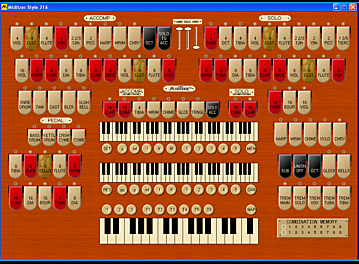
MIDI
and organs seem like a natural combination. But you will find
that it takes more than you might think to build an organ by connecting
MIDI keyboards to a MIDI synthesizer. That is what I discovered
when I started looking for a way to connect the Wurlitzer console I am
restoring to a MIDI synthesizer. Organs, theatre or classical, are choral instruments.
Stop tabs or drawknobs are
used to control what sound or sounds are produced when a key is played
on the keyboard. An essential part of playing an organ is using
the stops to set a registration. This creates a chorus of sounds
that
will be played. Stop control seems like the natural order of
things to an organist but it is apparently a foreign concept to most
other musicians including the architects of the MIDI specification. To build an organ
using MIDI signaling you need to add the equivalent of an organ
relay. Electropneumatic organs, which includes all theatre pipe
organs, include a large collection of switching equipment to combine
the signals from the keyboards and the stops to produce the signals
that operate the pipes. The Miditzer provides such a MIDI
relay. It allows you to connect MIDI keyboards in a way that will
provide the thrilling experience of playing a theatre organ. Many of you have
MIDI keyboards that will provide key signals but you don't have an
organ console to provide stop signals. The Miditzer has a
graphical user interface that allows you to control the stops with the
click of a mouse or a touch screen. If you don't have a MIDI
keyboard you can use your mouse to play the on screen keys. You
can also play and control stops with just your computer keyboard.
The thumb nail screen shot shows the controls that the Miditzer provides.

Go to the Downloads section of Virtual
Organ.com to hear
examples of the Miditzer recorded live with two keyboards and pedals by
Joe Barron. There is
no MIDI sequencing involved and no post processing of the file.
If you have a sound card that supports SoundFont®
compatible sound banks and a MIDI keyboard
connected to your computer, this is what you could be hearing from your
computer as you play. Joe also describes how he made a MIDI pedal
board and talks about using soft synthesizers with the Miditzer.
Richard "Bone Doc" Mogridge has downloadable files at his Walnut
Hill recording studios website.
The Bone Doc combines the Miditzer with MIDI overdubbing to get some
very
interesting recordings. He also has a lot of news about other
goings on in the virtual organ world.
On the next page, You'll learn how to get your computer set up so that you can have a virtual Mighty Wurlitzer of your very own! Once you have Miditzer playing you can learn more about how the console works from our tutorial..
For further discussion about getting your Miditzer going go to the MiditzerStartup Yahoo!Group